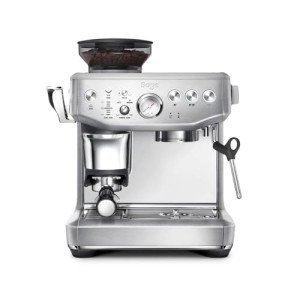The Ultimate Guide to Cappuccino Machines: Brewing the Perfect Cup
Cappuccinos are a cherished coffee beverage that integrates the rich flavors of espresso with steamed milk and milk foam. For lots of, nothing tastes better than a homemade cappuccino crafted with precision. Nevertheless, reproducing the skill of a barista in the house needs the best equipment. This is where cappuccino machines enter play. This post looks into the different types of cappuccino machines, how they work, and tips for choosing the best one for your requirements.
What is a Cappuccino Machine?
A cappuccino machine is a specialized brewing device created to make cappuccinos and other espresso-based drinks. These machines normally include a built-in espresso maker, a milk frother, and various controls for changing temperature level and pressure. Cappuccino machines can be manual, semi-automatic, or fully automatic, providing numerous levels of user control depending on the complexity of the machine.
Types of Cappuccino Machines
1. Manual Espresso Machines
- Description: These machines need users to operate most functions by hand, consisting of grinding coffee beans, tamping the grounds, pulling the espresso shot, and frothing the milk.
- Pros:
- Offers total control over the brewing process.
- Can produce high-quality, café-like espresso.
- Cons:
- Steeper knowing curve.
- Requires more time and effort.
2. Semi-Automatic Espresso Machines
- Description: Semi-automatic machines automate some processes, such as water pressure. Users still require to grind coffee and froth milk manually.
- Pros:
- Balanced control and convenience.
- Permits room for experimentation.
- Cons:
- Still requires useful abilities.
- Can be intricate for novices.
3. Fully Automatic Espresso Machines
- Description: These machines automate the entire developing process, from grinding to frothing. Users simply choose the desired drink.
- Pros:
- Extremely convenient and easy to use.
- Constant results with little effort.
- Cons:
- More costly.
- Limited control over the developing procedure.
4. Super Automatic Espresso Machines
- Description: Similar to completely automatic machines, however these models consist of features like an integrated milk frother and grinder. They prepare drinks with just the touch of a button.
- Pros:
- Ultimate convenience; makes different drinks rapidly.
- Integrated cleansing and upkeep features.
- Cons:
- High preliminary cost.
- Less hands-on experience with coffee making.
Secret Features to Consider
When choosing a cappuccino machine, several features can substantially affect efficiency and user experience. Here are some essential elements to assess:
1. Develop Quality
- Products utilized (stainless steel, plastic)
- Durability and longevity
2. Capability
- Water reservoir size
- Bean hopper capability
3. Frothing Capability
- Type of frothing wand (manual, automatic)
- Steam pressure and temperature level control
4. Alleviate of Use
- User-friendly controls
- Cleaning and upkeep requirements
5. Price
- Variety from budget to high-end designs
- Consider guarantees and client assistance choices
6. Brand name Reputation
- User reviews and skilled viewpoints
- Schedule of replacement parts
The Brewing Process
To brew the perfect cappuccino at home, follow this process, regardless of the machine type:
- Prepare the Espresso: Use freshly ground coffee beans and pull a double shot (approximately 2 ounces) of espresso.
- Froth the Milk: Steam fresh milk to a temperature about 150 ° F( 65 ° C)using the steam wand or automatic frother.
- Combine: Pour the steamed milk over the espresso, followed by a layer of milk foam (equivalent parts espresso and steamed milk, with about 1 cm of foam).
For a graph, here's an easy table comparing the attributes of the cappuccino machine types:
| Machine Type | Control Level | Reduce of Use | Rate Range | Perfect For |
|---|---|---|---|---|
| Manual Espresso Machine | High | Hard | Low to Medium | Coffee enthusiasts, purists |
| Semi-Automatic Machine | Medium | Moderate | Medium | Home baristas, hobbyists |
| Completely Automatic Machine | Low | Easy | Medium to High | Casual drinkers |
| Super Automatic Machine | Really Low | Very Easy | High | Busy professionals |
Often Asked Questions (FAQs)
What is the very best milk to use for cappuccinos?
Entire milk is commonly preferred for frothing due to its fat content, which develops a creamy texture. However, alternatives like almond milk, oat milk, or soy milk can be utilized, though they might require different frothing methods.
How do I tidy my cappuccino machine?
A lot of machines include particular cleansing instructions. Usually, you should frequently clean up the group head, steam wand, and drip tray. For automatic machines, lots of models include self-cleaning cycles.
Can I use pre-ground coffee instead of entire beans?
Yes, you can use pre-ground coffee. However, newly ground coffee usually produces a more tasty espresso due to the oils in the beans being protected.
How much should I spend on a cappuccino machine?
The cost differs considerably based upon functions, brand name, and quality. A fundamental, great quality machine might begin around ₤ 200, while high-end super automatic machines can go beyond ₤ 2,000.
How often should I change my cappuccino machine?
With proper maintenance, a high-quality cappuccino machine can last for lots of years. However, Pump Espresso Machines may think about updating if you discover your machine no longer fulfills your brewing needs or experiences performance problems.
Cappuccino machines are powerful allies in delivering the ideal brew in the house. Whether Bean To Cup Espresso Machines favor manual interaction with your coffee or choose the convenience of totally automated machines, understanding the various types and their features will assist you in making the best option. By purchasing Pump Espresso Machines for your needs and employing the right strategies, anyone can take pleasure in a barista-quality cappuccino from the convenience of their own kitchen. With a little bit of perseverance and creativity, the art of cappuccino brewing can end up being a delightful ritual, brewing not simply coffee but moments of pleasure.

